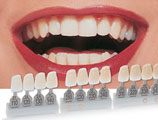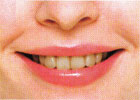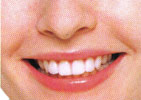Services: Aesthetics: Tooth Whitening
Tooth Whitening

Tooth whitening is a direction many people take when they discover their teeth have been discolored due to aging, by medications and chemicals or stained by beverages such as coffee and certain types of wine.
Whitening will not correct certain forms of discoloration. Teeth with bonding or certain tooth-colored fillings will not bleach and appear rather unsightly as a result. A dentist may recommend veneers, which cover the entire tooth, instead of whitening in these instances. However, whitening can be an ideal way to restore a healthy appearance to the teeth.
>> Find out more on Tooth whitening procedure
Types of Tooth Whitening
Depending on the amount of whitening needed and what the patient chooses, tooth whitening can be done:
- In a dentist's clinic or in-office tooth whitening
- At home or a take-home tooth whitening solution kit with an individualized customized tray

In-office teeth Whitening
When a patient chooses to have his or her teeth whitened in a dentist's office, the dentist applies a gum gel to protect the soft tissues of the mouth, then applies a bleaching agent to the teeth then activate the gel with laser. It takes just one hour for the in-office teeth whitening treatment to be completed. Types of in-office teeth whitening includes:
- Laser Teeth Whitening
- Zoom Teeth Whitening
- BriteSmile Teeth Whitening
Take Home Tooth Whitening
When a person would rather try tooth whitening at home, there is a choice of using an approved bleaching solution to be done at home. Most bleaches come in the form of a gel and are applied through the use of a mouthguard that varies in use from overnight application to twice-a-day insertion.
For take home tooth whitening, your dentist schedules the treatment plan according to his diagnosis, the tray is produced and you will be advised on the safe use of the system.


Contra-indications and Limitations of Tooth Whitening
We do not recommend bleaching for smokers or alcohol users. Smoking should be stopped before teeth are bleached. Smoking can cause tissue damage on teeth and may defeat the effect of whitening. The best candidates for whitening are those with stains caused by coffee, tobacco or aging.
|
Contraindications/Limitations of Tooth Whitening |
Comments |
| Extensive composite and porcelain restorations | If you have pre-existing cosmetic restoration (bonding, porcelain crowns or veneers) they will not be bleached and you may need to replace them in order to match your new color shade. |
| Pre-existing sensitivity | 2/3 of these people will experience some sensitivity for 1-4 days. This is usually reversible upon termination of bleaching. |
| Severe gray/blue banded tetracycline staining | Guarded prognosis required. Stains in the gray family (such as from tetracycline) can be harder to remove, if not impossible. These stains can take up to six months or longer to whiten. Whitening may only reduce amounts of 'masking'. |
| Discoloration in gingival third or exposed yellow | Guarded prognosis for whitening required. |
| Pregnant or lactating | No know adverse effects but avoid use as a precautionary measure. |
| Translucent teeth | May appear darker after bleaching. |
| Amalgam restoration in front teeth | Amalgams may need to be replaced to avoid 'greening effect'. |
| Temporomandibular Joint Disorders | May want to consider bleaching one arch and monitor comfort before proceeding with the other |
| Noncompliance or unrealistic expectation | The degree of whiteness is different from one individual to another, the degree of shade change obtainable is dependent on each person’s reaction. Certain people react well while others may not be as responsive. |
Frequently Asked Questions (FAQs)
- Is professional tooth whitening safe?
- How does the tooth whitening gel work?
- Is tooth whitening suitable for everybody?
- How long does the treatment take?
- How long does professional tooth whitening last?
- Do I have to consult my dentist in any case?
- What kind of whitening results can be expected with professional teeth whitening treatments?
- How many professional whitening treatments will a person need?
- Why are some professional teeth whitening systems followed up with an at-home whitener as well?
Is professional tooth whitening safe?
According to the lastest scientific findings it damages neither teeth and gums nor existing fillings you may have.
How does the tooth whitening gel work?
After examination by your dentist, your teeth will be cleaned. The teeth will be applied with a bleaching gel. A light source (such as laser light or plasma arch light) will be used to activate the gel then the gel releases oxygen that bleaches teeth discolorations in a gentle way, less heat and less sensitivity to the teeth.
Is tooth whitening suitable for everybody?
No. Always consult your dentist. Certain groups of people such as infants, pregnant women and nursing mothers must not be treated. Your dentist will advise you as to whether laser tooth whitening is suitable for you.
How long does the treatment take?
The tooth whitening should be finished within one hour and half.
How long does professional tooth whitening last?
This is very much related to your lifestyle. The blenching effect normally lasts between one and four years. The kind of food and drinks you consume, smoking habits, age and dental hygiene strongly influence the duration of the bleaching effect. Frequently drinking coffee, tea, or red wine as well as smoking can bring discolorations back quite quickly.
Do I have to consult my dentist in any case?
Yes. Your dentist can examine and work out the right dosage and treatment schedule. Advise from the practice team helps to avoid side effects and to control the results of the treatment.
What kind of whitening results can be expected with professional teeth whitening treatments?
There is no question that in the vast majority of cases teeth whitening with peroxide-based whiteners will produce results. The level of whitening obtained from the professional bleaching treatments is on par and similar in nature to those results you could achieve with a tray-based at-home teeth whitening system. The big advantage of professional whitening treatments is not the degree of lightening but the fact that you will experience the whitening effect immediately.
How many professional whitening treatments will a person need?
Sometimes dentists and/or the manufacturers of professional teeth whitening systems advertise their products as "one visit, one hour" type teeth whitening. One hour of professional in-office teeth bleaching treatment would be expected to provide a color change in a person's teeth.
The other side of this discussion is to state that it has been reported in dental literature that the average number of professional whitening treatments needed to "make the patients happy" was three. While results were seen after a single visit, it typically took between two to six in-office bleaching appointments to reach "maximum whiteness".
When determining if professional teeth bleaching treatments are the best whitening option for you, you should take into consideration that more than one whitening treatment might be needed. These extra appointments will require further time commitment and cost on your part.
Why are some professional teeth whitening systems followed up with an at-home whitener as well?
The protocol for some professional teeth whitening systems includes both in-office and at-home whitening treatments. This is becuase:
1) Some of the immediate tooth color change achieved by professional teeth whitening treatments may actually be due to a dehydration effect.
2) It can often take between two and six in-office bleaching treatments before a patient is satisfied with the degree of whitening that has been achieved.
The dentist / whitening product manufacturer is relying on the in-office bleaching treatment to provide a quick and noticeable color change. The at-home teeth whitening treatments the patient performs on their own helps to compensate for the short-term color relapse due to the loss of the tooth dehydration effect. Additionally, the at-home treatments take the total whitening effect possible for that person from using peroxide-based whiteners to its endpoint.
Professional teeth whitening treatments are characteristically performed on those teeth towards the front of a person's mouth. An important step associated with the safety of professional teeth whitening treatments is that the dentist isolates the teeth being bleached so that the whitener does not come into contact with the patient's soft tissues (gums, cheeks, and lips). This isolation is much more difficult to achieve with back teeth than with front teeth and this is why back teeth are often not treated during professional teeth whitening sessions.
There can be instances where a person's back teeth (especially their upper molars) do show prominently when they smile yet these teeth have not included in the whitening process. If this is the case the overall appearance of the patient's smile may not meet their expectations. Following the in-office whitening process with an at-home teeth whitening system can provide a means by which to lighten the back teeth so their coloration blends in and matches with the new shade of the anterior teeth. You will need to ask your dentist if there is an additional cost for the at-home teeth whitening products.
Source of informationtaken from VivaDent and http://www.animated-teeth.com.
Goto BIDC sub-website about tooth whitening in Bangkok.
Goto BIDC sub-website about BriteSmile tooth whitening in Bangkok.





